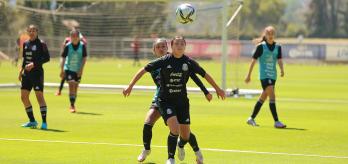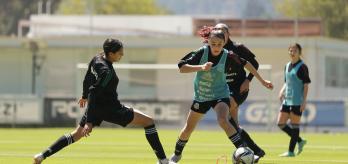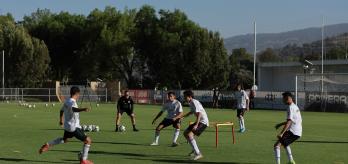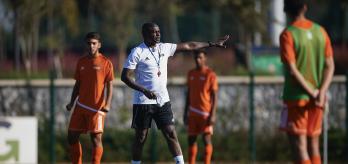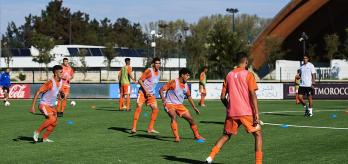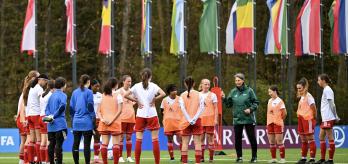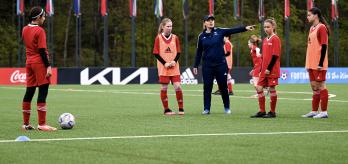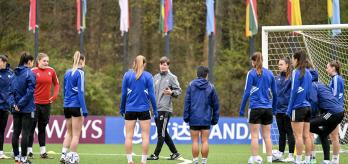This defensive organisation requires patience, discipline, good communication between the players and also aggression to try to recover the ball. Players must be able to constantly adjust their positioning based on the location and direction of the ball, their opponents, the space and their team-mates. In doing so, they should be able to maintain a tight block within the defensive lines. This makes it difficult for the opponents to find space to progress towards goal. By luring them high up the pitch, the team also create spaces that they can quickly counter-attack into and exploit once the ball is won.
This session, led by former Niger coach Oumarou Diabaté, aims to develop and master the principles of a low block with a group of 18 young players. The session is divided into five parts, starting with a warm-up that includes a technical part and a zone game. The rest of the session takes place on a half pitch, beginning with an analytical exercise during which a goalkeeper, four defenders and four midfielders practise the basic movements of a low block. The players then take part in some attack-versus-defence games, firstly 6v7, then 6v9, and finally 9v9.
Session overview
Key coaching points
- Master the principles of zonal defending such as pressing, covering and shuffling across, mutual cover between the lines, staggering the lines, compactness on the ball side, etc.
- Move together to remain compact goalside and narrow the shooting angle, as well as the opposition’s scope to play between the lines.
- Synchronise and coordinate player movement to cover for one another while maintaining the collective defensive organisation necessary to recover the ball.
- Improve communication between players to help with ball recovery.
Warm-up: pressing, covering and shuffling
The warm-up is divided into three parts. The first focuses on preparing the players physically for the session through the alternation of athletic ranges (knee raises, heel kicks, sidesteps, carioca, etc.) and a sequence of dynamic stretches. The second part is a warm-up with the ball in groups of four during which the players rehearse different passing drills. Finally, the third part consists of a zone game in which two lines of four players try to pass the ball to one another through a group of four defenders, who are placed between the lines.
- Mark out a 20x20m area and divide it into 4 horizontal zones, each 5 metres wide.
- 2 teams of 8 are divided into groups of 4 players and are then distributed inside each of the 4 zones.
-
Each team try to pass the ball from one zone to another without the 4 opponents between their zones intercepting it.
-
When the defenders win the ball, possession switches and that team try to retain possession.
-
To begin the exercise, the players are not permitted to leave their respective zones.
-
There is no pass limit within the same area.
-
The team in possession earn a point for each pass from one zone to another.
-
All passes are played on the ground.
-
A defender is allowed to enter the team in possession's zone in order to press and win the ball.
-
Apply the principles of pressing, covering and shuffling within a defensive line. The player closest to the ball comes out to press the carrier, while their partners tuck in behind to cover passing lines and remain compact. Players on the same line must move together in sync when play is switched to the other side.
-
Be patient and do not dive in. The player who presses the ball carrier must slow down upon approach so that they do not get easily beaten.
-
Win physical challenges in order to recover the ball.
Part 1: 8 plus goalkeeper v. 4: analytical exercise (half pitch)
In this exercise, Diabaté focuses on players' movement in the defensive phase and the coordination of their movement. A goalkeeper and a group of eight players positioned in two lines of four passively defend against a line of four attacking players spread across the width of the half pitch. The second goalkeeper is positioned on the halfway line and distributes the balls to the attacking team. Another group of four players wait and alternate with the four attackers.
-
The exercise takes place on a half pitch.
-
1 goalkeeper is positioned in the goal, the other is on the halfway line and acts as a server for the attacking team.
-
The group of 8 players are positioned in 2 lines of 4. The 4 defenders begin the exercise positioned in front of the penalty area. The 4 midfielders position themselves about 6 metres in front of the defence.
-
The 4 attacking players are spread across the entire width of the pitch.
-
The server passes to 1 of the 4 attacking players.
-
The 8 defenders and goalkeeper must react and organise themselves according to the direction of the pass and the position of the receiver.
-
The defenders should not engage in a duel with the ball carrier. The latter continues to try to protect the ball before returning it to the server.
-
The defenders need to get back into position before the next pass.
-
Towards the end of the exercise, the attackers pass the ball between themselves so that the defenders can practise what they have been working on in a dynamic situation.
-
The player who steps out to press the ball carrier must take short and dynamic steps to be able to decelerate when approaching the player and change direction if necessary. They must try to block a forward pass as they press the ball.
-
The whole defensive block must shuffle across to cover for the player pressing the ball. Each defender must follow the midfielder just in front of them to keep 2 lines of 4, whilst maintaining the same distances to enable them to put in a challenge/make an interception if necessary. When a midfielder steps out towards the ball carrier, the defender behind them must step forward with them.
-
Players must not anticipate a pass out wide at the risk of opening up the centre of the pitch.
-
The goalkeeper can see the whole pitch in front of them from their vantage point on the pitch. They must take advantage of this by giving instructions to their team-mates, as well as correcting their positioning if necessary. They must also move up the pitch with the defensive block to cover the space in behind and sweep up if a pass is played behind the backline.
-
The player pressing the ball carrier must immediately move back into their defensive line when the ball is played sideways, in order to maintain compactness.
Part 2: 6v6 plus goalkeeper: attack v. defence (small pitch)
The session progresses to an attack-versus-defence game comprising 6v6 plus a goalkeeper. The attacking team are set up in a 2-4 formation and the defending team in a 4-2 formation. Diabaté focuses here mainly on the positioning and movement of the two central midfielders as well as their role and responsibilities in a low defensive block.
-
The game is played on a half pitch.
-
A team of 6 attackers are positioned in a 2-4 formation and attack the goal.
-
6 defenders are set up in a 4-2 formation to try to recover the ball.
-
The ball starts with the goalkeeper in the attacking team.
-
The 6 attackers are encouraged to be patient in possession and to pass the ball around to disrupt the defensive block and give the coach the opportunity to correct the defensive players' positioning and movement.
-
When the defending team win the ball, they try to complete 10 passes to earn a point.
-
The 2 defending central midfielders must cover for each other and therefore avoid being positioned flat (i.e. in a horizontal line). When 1 of them steps out to press the ball carrier, the other must shift behind them to cover the space behind them.
-
They must also remain in a central position and avoid shifting towards the wide areas at the risk of leaving the centre of the pitch uncovered. When the ball is played out wide, the full-back must step out to press the ball carrier. The central midfielder must then cover the space behind them and block central passes.
Part 3: 6 plus 2 v. 8 plus goalkeeper: attack v. defence (half pitch)
The session then evolves with a game featuring eight plus a goalkeeper against 6 plus 2 support players in the same playing area. During this exercise, Diabaté corrects a few last details to ensure that the players have taken on board covering and shuffling, as well as the coordination of movement between the lines. The drill also encourages players to defend on the front foot and allows them to practise attacking transitions.
-
The game is played on a half pitch.
-
A team of 6 forwards are positioned in a 2-4 formation and attack the goal, with 2 support players positioned behind the halfway line.
-
8 defenders are positioned in a 4-4 formation to try to recover the ball.
-
Mark out 3 mini-goals using cones on the halfway line.
-
The ball starts with one of the 2 support players, who are limited to two touches.
-
The 6 attackers try to move the ball around to find gaps in the opposition's defensive block and to go on to score a goal.
-
The 8 defenders and their goalkeeper need to recover the ball and have 10 seconds to try to score in one of the 3 mini-goals or by carrying the ball over the halfway line.
-
If the defending team cannot score inside 10 seconds or the ball goes out of play, the 2 support players initiate a new phase of play.
- Mark out a 20x20m area and divide it into 4 horizontal zones, each 5 metres wide.
- 2 teams of 8 are divided into groups of 4 players and are then distributed inside each of the 4 zones.
- Players within the same line must shuffle across together to keep the centre of the pitch tight and protect the goal. When the ball is on one side of the pitch, the full-back furthest from the ball must tuck in centrally to stay compact with the 2 centre-backs, in order to be able to defend a cross and a switch of play.
- Players must also cover for each other between the defensive and midfield units to maintain compactness on the ball side, as well as in the centre of the pitch. When the ball is on one side of the pitch, the wide midfielder furthest from the ball drops to join the backline and stand in for the ball-side full-back, who stepped up to press the ball carrier.
- Players are encouraged to defend on the front foot when recovering the ball so they are able to counter-attack quickly. The 2 centre-backs must be ready to track their attacker should they drop between the lines to prevent them from receiving the ball without pressure, whilst the 2 full-backs need to be on the lookout for a possible interception when a pass is played towards the wing. Players must be able to react quickly to a loose or underhit pass, which will allow them to spring in.
Part 4: 9v8 plus goalkeeper: attack v defence (half pitch)
To conclude the session, two teams compete on a half pitch in a 9v9 game. The team attacking the goal are set up in a 3-4-2 formation, and the defending team play in a 4-4 system. This free game allows Diabaté to assess the players' understanding and to correct certain mistakes if necessary.
-
The game is played on a half pitch.
-
A team of 9 attackers are positioned in a 3-4-2 formation and attack the goal.
-
8 defenders are positioned in a 4-4 formation and try to defend their goal and recover the ball.
-
Mark out 3 mini-goals along the halfway line.
-
Play begins with the attacking team collecting a ball from behind the halfway line.
-
The 9 attackers try to move the ball in order to find gaps in the defending team that allow them to go on and score a goal.
-
The 8 defenders and their goalkeeper try to recover the ball to score in one of the 3 mini-goals or by carrying the ball over the halfway line.
-
The players put the principles worked on in the previous exercises into practice.
-
The game allows the 8 outfield players and their goalkeeper to practise and create rehearsed patterns specific to their team which they can then transfer into a real-match situation.
-
During the game, the coach ensures that the players respect and keep appropriate distances within and between their units to maintain a compact block that is difficult for the opponents to penetrate.








